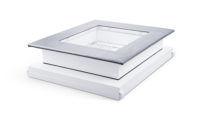The number and type of LED fixtures have rapidly expanded in recent years, so much so that they are now an excellent option for almost any type of facility, from manufacturing plants to retail stores. Of the numerous applications for LEDs, the cold chain stands to benefit the most.
There’s plenty to consider when planning lighting for a new building or upgrading existing lights. First of all, of course, is the cost involved. Although the price of LED fixtures has been steadily dropping, the upfront cost is still higher than older, less efficient forms of lighting. The trade-off is that LEDs use less energy and require almost no maintenance compared to their cheaper forbearers. Because of this, careful calculations are needed to determine how quickly the lights pay for themselves.
When return-on-investment is too close to call, facility managers examine the secondary benefits of LEDs such as superior brightness, a color temperature that simulates natural daylight and cooler operating temperature. It’s several of those secondary benefits that make LEDs the superior lighting technology for cold storage.
Heat savings
LEDs are known for their efficiency, especially when compared to old, but still common warehouse lighting technology such as metal halides. Replacing metal halides with equivalent LED fixtures can reduce energy usage up to 50%. In cold storage, however, the energy savings extend beyond the fixtures themselves.
That’s because as much as 75% of the energy used by metal halide lamps and incandescent bulbs is released as heat. The more lights, the bigger the problem. For example, 25, 450-watt metal halide lamps can produce about as much heat as a 45,000 BTU heater.
If the lights are left on for any length of time inside freezers or refrigerators, not only is energy wasted because of their inefficiency, but also the cooling unit is forced to work harder to compensate for the bulbs’ operating temperature and heat output. LEDs create negligible amounts of heat—about 120°F— compared to around 300°F for metal halides, which will reduce the time the compressor has to run.
Potentially longer fixture life
One thing that can shorten the life of LEDs is excessive heat. Because what little heat LED fixtures produce will dissipate far more quickly in a refrigerated storage area than almost any other type of facility, cold storage potentially has the ability to increase the life of LED boards and drivers.
This theory is still being tested as the highest-end LEDs are designed to last for decades. All predictive modeling, though, points to longer-lasting performance in colder areas.
To maximize the life span of the fixture even further, look for high-end fixtures with a large heat sink that helps dissipate the heat that naturally builds up in the fixture. And, search for fixtures that already offer an industry-leading lifespan of 150,000 hours under normal conditions.
Instant on-off
Even in the best cases, arc-based lighting has to warm up to reach full brightness. This can be anywhere from a couple minutes for fluorescents to 10 minutes for metal halides. This warm-up time is even longer in a cold storage environment—anyone who uses a fluorescent fixture is likely familiar with the dim, purple flicker of a cold bulb.
To keep the bulb at the desired brightness, workers have to leave them running, even if the area they’re lighting isn’t in use. That wastes energy. LEDs require no warm-up time to reach full brightness, even in cold environments. Once again, search for high-end fixtures rated to start in as low as -40°F temperatures.
Occupancy sensor won’t reduce the life of LEDs
Occupancy sensors are a great way to save energy, since they turn the lights on only when people are present. In the case of arc-based lighting, turning fixtures on and off can drastically shorten the life of the bulb and speed up the maintenance cycle.
The life of LEDs is not shortened each time they are turned off and back on, which makes occupancy sensors a sensible energy-saving accessory, especially in a refrigerated warehouse where some areas are rarely occupied.
Durability
There are only a few industries where you’re likely to cause impact damage to ceiling-mounted lights. Warehouses are one of those industries, especially cold storage areas, which often have lower ceilings than typical large warehouses.
LEDs in general are more shock-resistant than fragile glass bulbs, but some LED fixtures go a step beyond the standard sheet-metal housing. If the lights in your facility could potentially be damaged, seek LED fixtures made of anodized, extruded aluminum. They won’t blink even if a forklift hits them.
Light your space at your pace
Clearly, LEDs are well suited to cold storage facilities because of their energy efficiency, brightness, durability and long life, especially in low temperatures. But, like most facility decisions, choosing new fixtures often comes back to budget. In a large space, replacing every single fixture can be a big expense. But, upgrading to LEDs doesn’t have to be an all-or-nothing proposition.
Installing LEDs in phases allows managers to get a head start on facility-wide LED lighting while staying within yearly budgets and energy goals. If you have a facility that includes both traditional and cold storage space, install in the refrigerated area first. Chances are you’ll retire before they do.



